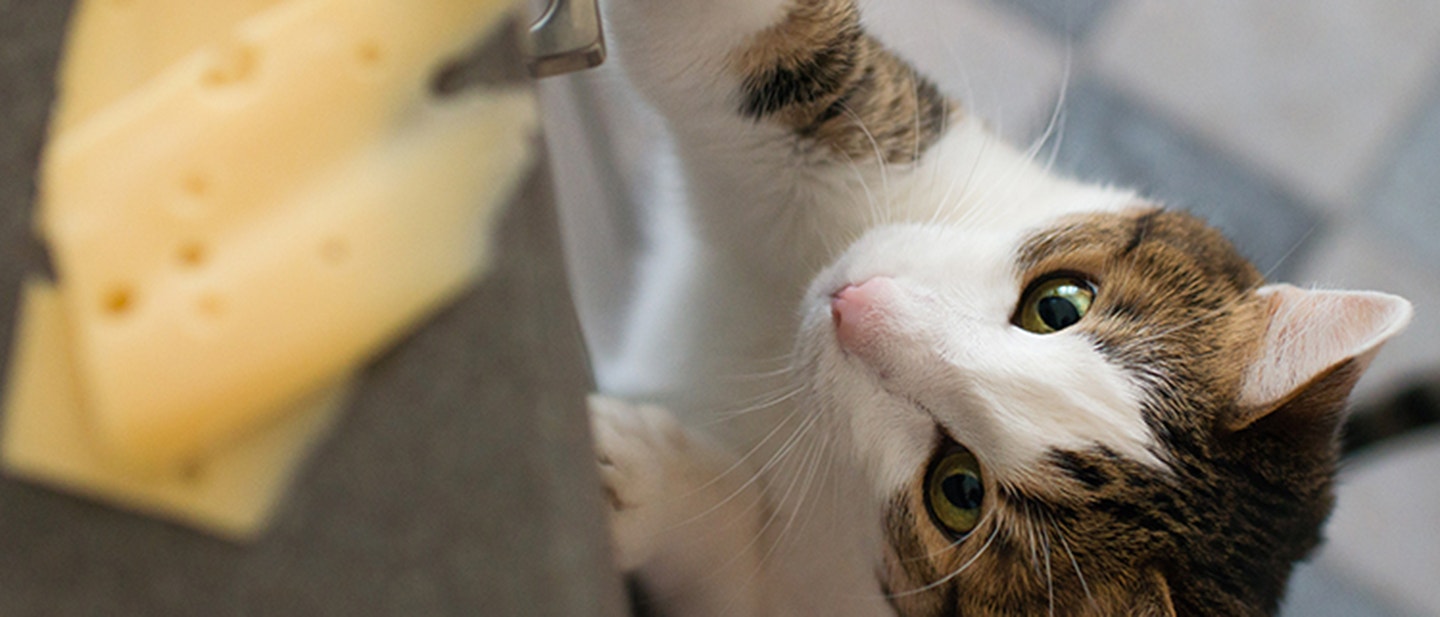
CAN CATS EAT CHEESE? WHAT HAPPENS IF THEY DO

Article checked by a vet
is one of the most popular food-related questions among cat owners.Contrary to popular belief, cheese (and milk) is not recommended as a regular treat because most cats are lactose intolerant. Cats cannot adequately digest dairy products even though some cats like to eat cheese anyway due to its flavour!
Cats are obligate carnivores and they require high-protein diets (at least 70% meat) containing little to no dairy products, this includes cheese, cream and milk. Unfortunately, cheese will not provide the right nutrition to support your cat, despite how tasty it might be.
Do cats like cheese? Dropping cheese can create instances of tantalising temptation. Many pet owners know that their cats like cheese and may also want to treat them on special occasions. Although a small amount of cheese is not too bad for cats, cheese offers no nutritional benefit and may contribute to weight gain or other long-term health issues.
What happens when your cat eats cheese?
Some pet owners may be unsure if cats can eat cheese and then notice their cats have diarrhoea shortly after eating it, this is why understanding digestive problems, symptoms and their causes in cats is very important for owners.
Once a kitten is old enough they lose their ability to digest lactose, which is initially needed for their development, their production of the enzyme lactase either slows down or stops entirely. It is important to understand that the milk kittens require from their mother when they are developing is very different from cow's milk and as such one is essential and the other is detrimental for healthy cats. Therefore, lactose intolerance is common in adult cats and is considered a normal part of their digestive development, rather than an illness. Cats that experience lactose intolerance or dairy allergies after eating cheese may display the following symptoms 12-14 hours after consuming it:
- Diarrhoea: Your cat may experience diarrhoea (loose bowel movements). This happens because the lactose cannot break down properly within the small intestine and continues into the large intestine.
- Vomiting: Your cat may also experience vomiting after consuming cheese.
- Abdominal Pain: Your cat may be in pain from trapped gas and aches from consuming cheese. They may also appear lethargic.
You must contact your vet if your cat experiences repeated or prolonged bouts of vomiting, diarrhoea, abdominal gas pain or has blood in their vomit or stool. Some cases of lactose intolerance may be more serious, depending on how much lactose your cat has consumed and how much pain they are in.
‘Can cats eat cheese' is one of many popular questions that new and existing cat owners may struggle to get a consistent answer to. It can be confusing introducing your cat to new foods like cheese. Generally, the longer a cheese has aged, the less lactose present. This means hard, mature cheeses contain less lactose than soft cheese and are more likely to be tolerated by cats.
Can my cat eat Cheddar Cheese?
In the UK, Cheddar is one of the most popular types of cheese found in our fridges. There are many different strengths of cheddar, from mild to mature. Because cats are lactose intolerant, we don't advise offering them cheese but if you do offer cheddar cheese, it should be in very small amounts in order to reduce abdominal discomfort or diarrhoea.
Healthy alternatives to cheese
At Perfect Fit we have formulated a range of delicious dry food products that meet your cat’s nutritional needs (a tasty alternative to cheese!) Our unique formulas support your pet at every stage of life. Our dry food range caters to indoor cats, neutered cats and cats with food sensitivities.
Other high-protein alternatives to cheese include small pieces of cooked, unseasoned meats such as chicken, turkey, or beef.
Cat-friendly snacks also include certain fruits (strawberries, melon, bananas) vegetables (carrots, peas, pumpkin) and even cooked eggs.
Ingredients to watch out for when reading labels
When studying the labels on cat treats it is important to note that ingredients are listed in order of weight, with the first few ingredients being the most prevalent. The first ingredient of any good high-quality cat treat should be a protein source such as chicken, turkey or fish, this indicates it will meet all your cat’s nutritional needs.
Commonly used kitchen ingredients known to be particularly harmful and toxic to cats include garlic and onions. Certain artificial sweeteners like xylitol also pose a threat to cats, xylitol can be found in most artificial sweeteners as well as other foods.
If you suspect that your cat may be severely affected by being lactose intolerant you should also screen treats for dairy and lactose on the labels and choose a fun treat free from these ingredients!
Cats are known to isolate themselves when they are in pain or feeling unwell and any sudden changes in their usual behaviour could be a red flag that something is wrong due to lactose intolerance.
It is key to note any changes in your cat's appetite, this includes any sudden disinterest in food or an unusual increase in hunger, which could indicate discomfort or an attempt to ease stomach pain due to lactose intolerance.
